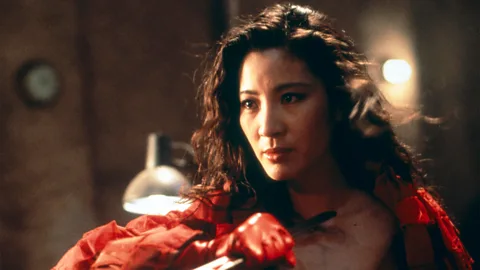 Eureka Entertainment
Eureka EntertainmentThere’s long been a misconception that action films are a masculine domain. But female strength and agility have been showcased on the big screen since the silent era.
When you think about action films, the default response is probably to think about men. The bulging musculature of Sly Stallone in Cobra (1986) or Arnold Schwarzenegger in vaguely goofy but endlessly entertaining films like Commando (1985) might come to mind; so too might the balletic, graceful fight choreography of Bruce Lee or the hulking ferocity of a Jason Statham. Equally, the behind-the-scenes role of the stunt person, although stars of all gender require them, has been associated in the popular imagination with masculinity: think wrecked Aston Martins on a multi-million budget James Bond set, legendary western stuntman Yakima Canutt climbing under a wildly careening horse-led stagecoach, or testosterone-soaked shoot ’em ups like John Wick, directed by former stuntman Chad Stahelski.
However this is far from the whole story. In the British Film Institute’s current blockbuster national film season Art of Action, celebrating the history of action cinema from its earliest days onward, you might catch any number of roundhouse-kicking tough guys. But as season curator Timon Singh tells the BBC: “I think there is this misconception that ‘action films’ are mostly for men, but female action stars and stunt performers have been there since the beginning of cinema.” And Art of Action has set out to prove it.
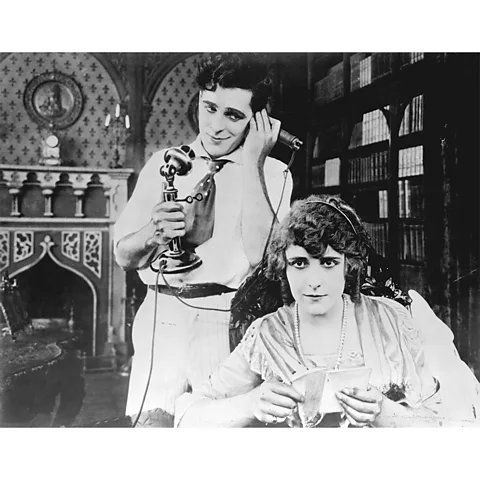 Getty Images
Getty ImagesThere’s the iconic Hollywood action roles like Carrie-Anne Moss in The Matrix (1999) or Uma Thurman in Kill Bill: Volumes 1 and 2 (2003-4); but there are also the heroines who did their own stunts, like Pam Grier, the blaxploitation star of the 1970s with a black belt in karate. Or Michelle Yeoh, a Malaysian beauty queen with a background not in martial arts but in dance. Her work in Hong Kong action movies of the 1980s and 1990s would help redress the male-dominated nature of that cinema scene.
If you scratch beneath the action genre’s macho mythology even a little bit, you soon realise that action heroines, stunt queens, and female martial artists are all over cinema history, behind and in front of the camera. As Georgia Munroe, professional parkour athlete and stuntwoman on films including Jurassic World and Wonder Woman 1984, says: “We have long been capable of setting our own boundaries, taking hits and helping with lifting equipment to set.”
The contemporary role of the tough-girl action hero also owes something to the emergence of strong female characters of decades before. Think of characters with physical strength and ability – like Sigourney Weaver’s Ellen Ripley in Alien (1979) and Linda Hamilton’s Sarah Connor in Terminator 2: Judgment Day (1991). These were characters who demonstrated that women could embody both resilience and complexity, setting the stage for the 21st-Century female action star. Today, the daring of superheroines like Scarlett Johansson as Black Widow and Zoe Saldana in the Guardians of the Galaxy franchise – as well as the athleticism and grace of stuntwomen like Zoe Bell – owes much to those pioneers.
But as Munroe notes, there are also still double standards that come with being a stuntwoman or action queen. “We always have to prove ourselves regardless of our level of experience. You feel the pressure to get things right the first time, in order to save face and, show you deserve to be in that position. If it goes wrong, it feels like the judgement is much harsher on us,” she says.
The Hong Kong Connection
A landmark film in the Art of Action season is Yes Madam (1985), in which a young, new-on-the-scene Michelle Yeoh stars opposite fellow tough-girl action star Cynthia Rothrock, as cop partners tracking down thieves. Rothrock, a US world champion martial artist who found a better path to stardom in the popular Hong Kong movies than she did in her homeland, would spend several years making films there. Rothrock broke barriers as one of the first US women to achieve stardom in the martial-arts film industry, and her ability to perform complex fight scenes with grace and power challenged stereotypes – and redefined the role of women in action cinema. In addition to her film work, Rothrock has been an advocate for martial-arts education, teaching and inspiring many aspiring martial artists around the world. Her dedication to the craft and her contributions to the genre have earned her a devoted fan base.
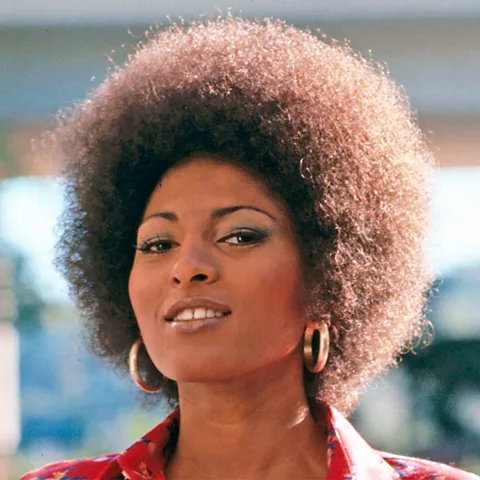 Getty Images
Getty ImagesMeanwhile, Yeoh’s turn in Everything Everywhere All At Once (2022) mixed high-kicking action with comedy and emotional family drama and brought her a long-overdue Academy Award. Yet she has always been a remarkable screen performer, with her earlier Hong Kong work – including the surreal supernatural flick The Heroic Trio and her incredible turn opposite Jackie Chan in Police Story 3 – proving that you needn’t be professionally-trained as a fighter to become a badass action queen. In doing so many of her own stunts over the years, Yeoh has had to overcome the same tough injuries that a no-name stuntperson might. “The stunt that had the worst impact [for me] was in The Stunt Woman (1996). I played a stunt person and landed completely wrong, nosediving into the landing area,” she said in a 2019 interview. “I folded and heard my back snap! Psychologically and physically, that injury took the longest to recover from.”
“Starring in the Bond film Tomorrow Never Dies (1998) and following it up with Crouching Tiger, Hidden Dragon (2000) gave Michelle Yeoh huge international acclaim,” Singh says. “But her earlier films like Yes Madam!, Royal Warriors and of course Police Story 3: Supercop are a wonderful introduction to her back-catalogue for audiences that might only be familiar with her work from [Hollywood movies like] Crazy Rich Asians or Everything Everywhere All At Once.
“Asian cinema has had a massive impact on the global perception of female-led action. People might first think of Uma Thurman in Kill Bill when thinking of female action stars, but the likes of Meiko Kaji in Lady Snowblood (1973) and Angela Mao in Lady Whirlwind (1972) were clear inspirations for Tarantino in his revenge saga,” Singh adds.
Several cinemas across the UK are now showing “girls with guns” films – the sub-genre of female-and-firepower led Hong Kong action films said to have started with Yes Madam – as part of the Art of Action season, including Nottingham’s Broadway Cinema and Bristol’s Watershed. The latter’s programming is even curated by a maker of action flicks herself – Nida Manzoor, director of last year’s acclaimed action-comedy-kung-fu hybrid Polite Society. Her snappily titled Girls Just Wanna Have Guns film series at Watershed screens throughout the month of November.
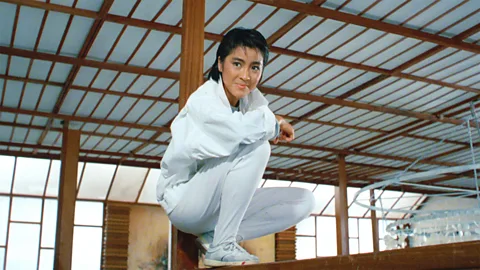 Eureka Entertainment
Eureka EntertainmentAs for Manzoor herself, she represents the next generation of film-makers inspired by the courage and athleticism of those who came before. Polite Society is, after all, about a girl who wants to be a stuntwoman when she grows up, and idolises British Gladiators star of the 1980s, Eunice Huthart. Huthart went on to become a double for Angelina Jolie and one of the biggest stunt coordinators in the UK, overseeing many of the stunts for major Marvel films; her voice appears in Polite Society as an encouraging force to the heroine, showing just how key the legacy of the past is for stuntwomen and action queens of the future.
The Serial Queen Pioneers
A casual observer might assume that action queens are a relatively recent – or at least post-feminism – phenomena. And it’s true there certainly were a glut of them in particular eras, even if their representation of female strength, agility or power was flawed. For instance, the girl-power action babes of the 90s and early 00s were as in thrall to the male gaze as they were capable of kicking ass; Milla Jovovich in the Resident Evil films or Jolie as Lara Croft, for instance. But plucky, courageous women who led blockbuster action or thriller films aren’t new or emergent from recent decades, as Timon Singh points out, citing “the likes of Helen Gibson, Mary Fuller or Pearl White – the star of the hit serial The Perils of Pauline”.
In the 1910s, “serial” films – episodic shorts not unlike television series shown at the cinema – were all the rage. Among the most famous of these were The Perils of Pauline (1914), starring Pearl White, dubbed the “peerless, fearless girl”, whose death-defying willingness to do her own stunts included high-speed chases, jumping from cliffsides, and generally proving she had just as much mettle as the men of their time. Silent-era stuntpeople were not known for kowtowing to health and safety. But while daring silent male comedians like Buster Keaton (whose nickname came from his ability to absorb slapstick injury) are often celebrated by stuntpeople today, fewer of them discuss the female pioneers of early motion pictures. Pearl White was joined in the ranks of so-called “serial queens” by several others who were similarly audacious, like Helen Gibson, whose 119-episode Hazards of Helen (1914-17) saw her trapped in real burning train cars and facing discrimination from the men around her in real proto-feminist fashion.
In an era when women were still fighting for suffrage, there were female daredevils and performers willing to put life and limb on the line for our thrills. That they were also flying in the face of the norms of expected “womanly” behaviour – unwilling to sit on the sidelines when they could get behind the wheel of a speeding car or fall from a great height – is worth celebrating. They proved female strength and resilience in a business where beauty was typically the be-all and end-all.
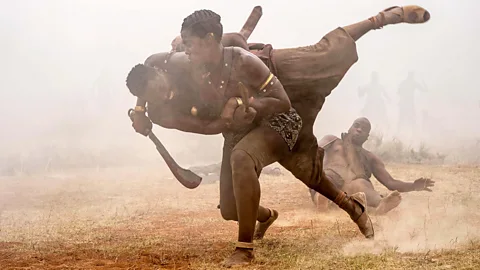 Alamy
AlamyAs Munroe points out, even today, she sometimes has had to “perform stunts in clothing that isn’t always realistic, or possible to get protective pads under. Here’s a superhero or badass assassin, wearing clothing that hardly covers their body and has high heels,” she says. “Sex appeal is sometimes prioritised over necessity”. But she is excited for the future, pointing to The Woman King (2022) as a recent film that prominently features strong, capable women of colour, and that utilises their athleticism in remarkable ways. Championing these women action stars on the screen – and highlighting the lineage they are a part of – is a much-needed corrective to the idea that action movies are a masculine domain; seeing one roundhouse kick from Cynthia Rothrock is sure to dispel that notion. As Munroe says: “It’s important to celebrate stuntwomen and action heroines because film and TV form an integral part of what shapes people’s perspectives. The more light that is shed on what these women are capable of, the more that potential is spread. Then it becomes reality for other women and girls around the world.”
The Art of Action season continues at the BFI Southbank, around the UK and on BFI player through November and December 2024





:max_bytes(150000):strip_icc()/TAL-hotel-courtyard-CASADRAGONES1124-b626a84511a54004acaae464b2fd103f.jpg?w=1068&resize=1068,0&ssl=1)
